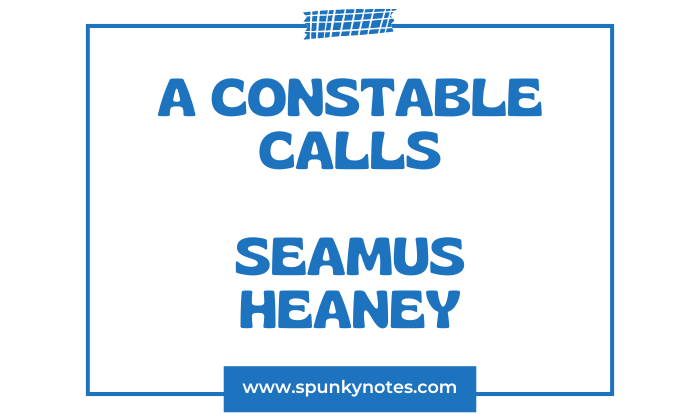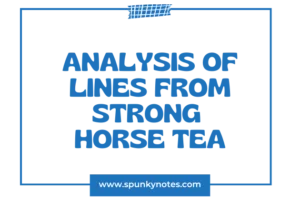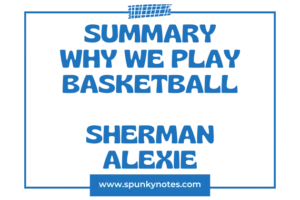
Q. Critically explain A Constable Calls by Seamus Heaney.
“A Constable Calls” is a poem by Seamus Heaney, the renowned Irish poet and Nobel laureate. This poem is from his collection “North,” published in 1975.
It shows the tension and fear in Northern Ireland during the political unrest, often referred to as “The Troubles.” Seamus Heaney received the Nobel Prize in Literature in 1995.
“A Constable Calls” by Seamus Heaney is a poem that describes a moment from the poet’s childhood in Northern Ireland, set against the backdrop of the political tensions and violence known as the Troubles.
In this poem, a police constable arrives, presumably from the predominantly Protestant Royal Ulster Constabulary, at the Catholic Heaney family’s farmhouse. Because of religious differences, this creates a tense and possibly dangerous situation.
The visit, part of routine policing during the Troubles, is seen through the eyes of a child—likely Heaney himself.
Critical Explanation of A Constable Calls
Stanza 1
His bicycle stood at the window-sill,
The rubber cowl of a mud-splasher
Skirting the front mudguard,
Its fat black handle grips
In the opening lines of “A Constable Calls,” Seamus Heaney vividly describes a police constable’s bicycle, emphasizing the tense atmosphere his presence creates.
The bicycle, resting by a window-sill, introduces the constable’s intrusive authority. Heaney meticulously notes the “rubber cowl” of the mud splasher, a protective covering on the bike that shields against mud.
This specific detail highlights the speaker’s acute awareness and possibly his anxiety. “Skirting the front mudguard” refers to the mud-splasher’s position, running along the bike’s front mudguard.
This close observation suggests a sense of wariness or suspicion.
The “fat black handlegrips” are described in a way that imbues them with a menacing quality, reflecting the overwhelming nature of the constable’s power.
Stanza 2
Heating in sunlight, the “spud”
Of the dynamo gleaming and cocked back,
The pedal treads hanging relieved
Of the boot of the law.
Heating in sunlight, the “spud
This phrase depicts a part of the bicycle, likely the metal connector of the dynamo, heating up in the sun.
The word “spud” here is colloquial, suggesting something small and stubby.
This detail brings a sensory image to the scene and could symbolize the latent power or potential violence associated with the constable’s presence.
Of the dynamo gleaming and cocked back,
The dynamo, a device on the bicycle for generating electricity for the lights, is described as gleaming and being in a position that is ‘cocked back.’
This imagery could be reminiscent of a weapon being prepared for use, adding to the sense of threat or impending action.
The phrase “cocked back” typically refers to something being pulled back or positioned at an angle, ready for action.
It is often used in the context of firearms, where “cocking” a gun means to pull back its hammer or slide to make it ready to fire.
In Seamus Heaney’s poem “A Constable Calls,” when he describes the dynamo of a bicycle as “gleaming and cocked back,” it suggests that the dynamo is positioned in a way that is reminiscent of a weapon being prepared for use.
The imagery implies that even mundane objects associated with the constable carry an air of authority and latent power.
The pedal treads hanging relieved
The bicycle pedals are described as ‘hanging relieved,’ suggesting they are at rest, perhaps because the constable has dismounted.
This phrase might imply a temporary cessation of authority or surveillance, giving a brief respite.
Of the boot of the law.
This metaphorically refers to the constable’s authority (the law) as a ‘boot,’ implying an oppressive, heavy presence. It suggests that the law is not only a protective force but also a potentially oppressive and controlling one.
The phrase “the boot of the law” is used metaphorically to represent the presence and power of legal authority, in this case, embodied by the constable.
Stanza 3
His cap was upside down
On the floor, next his chair.
The line of its pressure ran like a bevel
In his slightly sweating hair.
His cap was upside down
On the floor, next his chair.
It presents a moment of casualness or unguardedness as the constable’s cap is placed upside down on the floor beside his chair.
This detail could signify a temporary relaxation of authority, as the constable is inside, possibly in a domestic setting, and has removed his cap, a symbol of his official role.
The line of its pressure ran like a bevel
In his slightly sweating hair.
Heaney describes the mark left by the cap on the constable’s hair. The pressure line from the cap resembles a bevel, a sloped edge, indicating how tightly the cap was worn.
The detail of “slightly sweating hair” humanizes the constable, showing him as more than just an authoritative figure; he is also a man, possibly affected by the tension of his job.
Stanza 4
He had unstrapped
The heavy ledger, and my father
Was making tillage returns
In acres, roods, and perches
He had unstrapped
The heavy ledger,
This ledger is likely a record book or an official document, symbolizing the bureaucratic aspect of law and authority.
The adjective “heavy” not only refers to the physical weight of the ledger but also metaphorically suggests the weight of the authority and scrutiny it represents.
And my father
Was making tillage returns
In acres, roods, and perches
The speaker’s father is shown responding to the constable’s authority by making ’tillage returns’, which are reports or declarations of the amount of land under cultivation.
The mention of acres, roods, and perches (traditional units of land measurement) emphasizes the meticulous nature of this task and situates the poem in a rural setting.
Stanza 5
Arithmetic and fear.
I sat staring at the polished holster
With its buttoned flap, the braid cord
Looped into the revolver butt.
Arithmetic and fear.
This brief, powerful statement juxtaposes the mundane task of calculating land measurements (arithmetic) with the deep-seated emotion of fear.
It succinctly captures the underlying anxiety and apprehension that permeates the encounter with the constable.
The arithmetic represents the routine, everyday aspect of life. At the same time, fear indicates the constant undercurrent of threat and intimidation in this setting, likely reflecting the broader context of political tension in Northern Ireland.
I sat staring at the polished holster
With its buttoned flap, the braid cord
Looped into the revolver butt.
The speaker, presumably a young Heaney, describes his fixation on the constable’s holster and revolver.
The attention to detail of the polished holster, the buttoned flap, the braid cord, and the revolver butt highlight the child’s fascination and fear.
The braid cord is likely a decorative or functional part of the holster design, possibly used to secure the weapon or as a part of the holster’s fastening mechanism.
Stanza 6
Any other root crops?
Mangolds? Marrowstems? Anything like that?”
“No.” But was there not a line
Of turnips where the seed ran out
Any other root crops?
Mangolds? Marrowstems? Anything like that?
The constable’s questions about specific types of root crops mangolds (a type of beet used mainly for animal feed) and marrowstems (another term for a similar type of crop) indicate a thorough and probing investigation.
This line of questioning reflects the level of detail and control that the authorities exercised over agricultural practices, which could be a source of anxiety for farmers.
“No.” But was there not a line
Of turnips where the seed ran out
The speaker’s father responds with a simple “No,” possibly indicating his reluctance or fear in dealing with the constable.
However, the speaker (or narrator) then reflects on a specific detail: a line of turnips that grew where the seed of another crop had run out.
This observation might symbolize the small, unnoticed aspects of life that fall outside the rigid scrutiny of authority, or it could represent a subtle form of resistance or non-conformity.
Stanza 7
In the potato field? I assumed
Small guilts and sat
Imagining the black hole in the barracks.
He stood up, shifted the baton-case
In the potato field? I assumed
Small guilts and sat
The speaker reflects on the possibility of minor oversights or errors (‘small guilts’) in the potato field, which might interest the constable.
This assumption of guilt, even for trivial matters, highlights the pervasive sense of fear and the pressure to comply with authority.
The child’s perspective is particularly poignant here. He internalizes the situation’s anxiety and feels a sense of guilt even though no wrongdoing has occurred.
Imagining the black hole in the barracks.
The “black hole in the barracks” is likely a reference to a prison cell or a place of confinement within a police station (‘barracks’).
This imagery suggests the fear of punishment and the ominous power of the constable.
The child’s imagination of such a dark, confining space underlines the sense of dread and the oppressive nature of the authority represented by the constable.
He stood up, shifted the baton-case
The constable’s movement, standing up and shifting his baton case, signals a change in the scene. This action may indicate the end of the interrogation or the readiness to leave.
The baton case, another symbol of authority and potential violence, reminds the constable of his power and the ever-present threat of law enforcement.
Stanza 8
Further round on his belt,
Closed the domesday book,
Fitted his cap back with two hands,
And looked at me as he said goodbye.
Further round on his belt,
This line likely describes the constable adjusting something on his belt, which could be his baton case or another uniform item.
With its various attachments, the belt symbolizes the constable’s authority and readiness.
Closed the domesday book,
The ‘Domesday book’ here is a symbolic reference to the ledger or record book the constable had been using.
The term’ Domesday Book’ alludes to the comprehensive record of land and property in England commissioned by William the Conqueror in 1086, suggesting the thorough and final nature of the constable’s records.
This action signifies the end of the official inquiry.
Fitted his cap back with two hands,
And looked at me as he said goodbye.
The constable putting his cap back on with both hands is a deliberate action, restoring his formal appearance as he prepares to depart. The cap is a symbol of his official role and authority.
This moment of eye contact shows a human connection, a final assertion of authority, or an acknowledgement of the tension.
Stanza 9
A shadow bobbed in the window.
He was snapping the carrier spring
Over the ledger. His boot pushed off
And the bicycle ticked, ticked, ticked.
A shadow bobbed in the window.
It suggests the constable’s presence is still perceptible, even as he prepares to leave.
Using “bobbed” gives a sense of movement, indicating the constable’s ongoing activity. Shadows often symbolize something intangible yet ominous, hinting at the continuing impact of the constable’s visit.
He was snapping the carrier spring
Over the ledger.
The constable secures the ledger with a carrier spring, presumably containing records or notes from his visit. Snapping the spring shut signifies the conclusion of his official business.
The closed ledger, a symbol of authority and monitoring, shows that the close examination has ended.
His boot pushed off
The constable begins to leave, pushing off with his boot, a motion associated with starting to ride a bicycle.
The boot, earlier a symbol of oppressive authority (‘the boot of the law’), signifies the constable’s physical departure here.
And the bicycle ticked, ticked, ticked.
The bicycle ticking as it moves away leaves a lasting sensory impression.
This repetitive ticking could symbolize the ongoing passage of time and the lingering presence of authority. It is a subtle reminder that while the constable has left, his influence and the tension he created remain.

